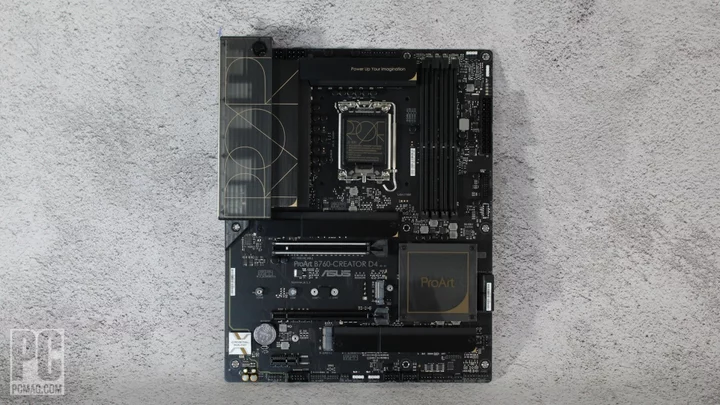Designed for users of high-end creative apps, the Asus ProArt B760-Creator D4 motherboard ($229.99) is ideal for 4K video editing, 3D work, or CGI rendering on smaller budgets. Compared to most of the gaming motherboards we see, the ProArt has a much more professional, sober appearance, without RGB lighting. It also features a plethora of connectivity: four SATA ports, three M.2 sockets, dual Ethernet ports, and enough power delivery for Intel's flagship CPUs. Since it supports DDR4 in place of DDR5 memory, your overall cost to get into the platform will be marginally lower. It's a solid pick for creators looking to build or upgrade a PC with a late-model Intel LGA1700 chip but not go into the overclocking wilderness with it.
Board Design, CPU, and Memory
The B760 Creator-D4 sports a matte black PCB with black heatsinks cooling all the necessary bits. Like the chipset, the rear I/O cover has a translucent smoke look with ProArt branding in gold. The voltage regulator module (VRM) heatsinks have enough mass and surface area to do their job and match aesthetically with the black and gold highlights. Though you'll find no integrated RGB lighting here, you will find plenty of headers to attach your own, controlled via the Armory Crate software by Asus. Ultimately, the ProArt is a decent-looking board that doesn't call attention to your build out of the box.
The motherboard supports Intel's 12th and 13th Generation LGA 1700 processors up to the flagship Core i9-13900K/KS. The 12 power stages dedicated to Vcore use 50-amp MOSFETs. While the total 600A available isn't a lot, it proved enough to handle our test CPU easily running within spec. (Remember, overclocking is extremely limited on B760 boards without a clock generator.) You'll hit the limit of ambient cooling before power delivery becomes a problem.
As mentioned, the board supports DDR4 memory, which at least as of this writing remains cheaper than DDR5 (and brings some minor performance hit depending on the application, but typically no more than a few percent). Asus lists support up to DDR4-5333, which is around the chipset's peak; I tested the motherboard with my DDR4-3600 kit with roaring success. After installing the kit, I enabled XMP and was off with a stable system as expected.
In addition to the "sweet spot" DDR-3600, I tried the ProArt with the fastest DDR4 I had on hand, GSkill's Trident Z Royale DDR4-4000. This, too, was perfectly stable using the XMP settings. Currently, kits faster than DDR4-4000 tend to bring diminishing returns in terms of real-world performance versus expense. Your mileage may vary, but sticking to the QVL list works without issue.
Layout and Internal Connectors
Starting at the top left of the motherboard, we run into 8-pin (required) and 4-pin EPS connectors to power the processor. Below them are the black heatsinks sporting a brushed aluminum finish and ProArt branding. Again, the B760-Creator D4 won't stand out in your chassis, but it isn't something you'll have to hide, either.
Above the socket area and the top set of VRMs are the first three of seven 4-pin fan headers. Each header supports PWM and DC-controlled devices and outputs up to 1A/12W, which should be enough for most situations, though I wouldn't piggyback multiple fans on each header and would have liked to see a higher value (such as 2A/24W) for the pump header. Additional 4-pin headers are found on the bottom of the board and one more below the socket. Control over attached fans and pumps is available via the BIOS or the Armoury Crate software.
Continuing our trip to the right, we run into four unreinforced DRAM slots with the locking mechanism at the top. If you crave RGB lighting, you'll find multiple headers available; you'll find one 3-pin ARGB and one 4-pin RGB header in the upper right corner. (Two more 3-pin headers reside on the bottom edge.) You can control lighting through the Armoury Crate and Aura RGB apps.
Also in this area is a four-LED Q-Code, a handy troubleshooting feature that lights up during the POST process and lets you know what stage you're at. If you hit a snag in these critical times, the offending part's LED (CPU, boot, DRAM, VGA) remains lit. Moving downward, we run into the 24-pin ATX power connector for the board, a front-panel USB 3.2 Gen 1 Type-A (5Gbps) header, and a front-panel USB 3.2 Gen 2 Type-C (10Gbps) header. Sadly, this board doesn't include a PCIe EZ-Latch, but few will likely miss it.
At the bottom left of the board, hidden under the Crystal Sound-labeled Faraday cage, is a budget Realtek ALC897 codec and a couple of audio capacitors. While the ProArt doesn't come with its own amplifier or DAC, its audio should be adequate for most users. If part of your creative workflow requires audio production, you may want a higher-quality add-on sound card.
Two full-length and two x1-size PCI Express slots are in the middle of the board. The full-length slots are generally used for graphics cards, while the small slots are for expansion cards that don’t require much bandwidth. Mixed in around these are three M.2 sockets. Sliding past the chipset heatsink to the right edge, we find the four SATA ports.
Expansion, Storage, and Rear I/O
The top full-length PCIe slot connects through the CPU and is the only PCIe 5.0 x16 slot. The second full-length slot and the x1 slots all source their lanes through the chipset, with the former running at PCIe 4.0 x4 speeds and the latter at 3.0 x1. You'll see some lane sharing with the PCIe x1 slot which I'll detail below.
All three M.2 sockets peak at PCIe 4.0 x4 speeds, as you won't find a PCIe 5.0-capable socket onboard. The top socket supports up to 80mm modules and connects through the CPU, while the bottom two sockets connect through the chipset. The M.2_2 socket supports up to 110mm modules and runs at PCIe 3.0 x4 speeds, while the third socket also supports 110mm parts. Note: That second M.2 slot does share bandwidth with PCIe x1 and Wi-Fi Key-E. If anything is installed in those, the second M.2 runs at PCIe 3.0 x2 speeds. If that's the case, be sure to install your slowest M.2 drive in this socket.
The rear I/O resides on a preinstalled plate with a black background, gold port labeling, and ProArt branding. Nine USB ports take up most of the real estate, with a 10Gbps Type-C and four 10Gbps USB 3.2 Gen 2 Type-A ports being the fastest of the bunch. You’ll also find four USB 2.0 (480Mbps) ports here. DisplayPort and HDMI options are available on the left if you plan to rely on your processor's integrated graphics. The audio stack consists of five 1/8-inch plugs, along with an optical S/PDIF port. On the network side are two Ethernet ports, one 2.5Gbps and the other 1Gbps.
UEFI BIOS and Utilities
The B760-Creator D4 BIOS uses Asus' familiar layout but with a blue, black, and white background. The EZ-Mode is mostly informative, though it lets you change some settings; it shows high-level system info including the processor, RAM, BIOS version, fan control, and storage.
The advanced portion of the BIOS provides the usual configuration with major headings across the top, including My Favorites (customizable), Main, Ai Tweaker, Advanced, Monitor, Boot, and Tools. All the advanced functionality is in this much more comprehensive mode.
The Ai Tweaker section contains all the options to tweak and overclock your system. Here you can adjust voltages, RAM speeds and timings, and overclocking options. Since the B760 platform doesn't overclock the processor, you're limited to tweaking voltage and memory, but you'll see plenty of options available to do so.
Inside the Advanced section are several subheadings where you can adjust platform power and configure I/O ports plus PC Health, which displays system information including voltage and temperatures. Here you'll find options to turn audio and integrated graphics on or off and configure USB, NVMe, SATA, audio, and network hardware, among a slew of other functionality.
The monitoring section displays detailed information about temperatures, fan speeds, and voltage, and it also provides Q-Fan configuration to adjust your fan profiles. Canned profiles are included, and you have the ability to create and save your own custom fan curves.
The BIOS is logically laid out, easy to read, and simple to navigate. The B760 version has a full array of tweaks, including those to overclock RAM. Asus' BIOS is perhaps my favorite as everything is easy to manage. It provides all the options you need, and our 0812 version proved stable in our time with the board.
On the software side, Asus has Armoury Crate, which provides a raft of functions including system tweaking and monitoring and control of RGB lighting and fans. The application matches the company's ROG, rather than ProArt, theme and is easy to work with. The first screenshot below shows the landing page, all the hardware it can control on our test system, and the fan and RGB functions below.
Fan Expert 4 controls all the fans and water pumps connected to the 4-pin headers. You can cycle through four canned settings or customize each header with your own curves.
The Aura Sync section controls the RGB lighting and includes several preset modes (static, breathing, color cycle, rainbow, comet, glowing yo-yo, starry night, flash and dash, and strobing). You can fine-tune each mode individually.
Asus provides complete Windows software solutions to control just about anything in the BIOS. If you want to overlock (on a board that allows it), I'd recommend the AI Suite 3 software, as it gives you the most control over the processor. That's not a factor here for the CPU, though.
Verdict: A Budget Platform for Creative Pros
The Asus B760-Creator D4 is a full-featured motherboard at a budget-friendly price. While it doesn't offer 40Gbps ports like high-end Creator boards, you get a 20Gbps front-panel USB-C port, dual LAN ports around back, a PCI Express 5.0 expansion slot, three M.2 sockets, and power delivery worthy of flagship-class processors. The black-on-gold ProArt look is more subdued than sensational, but you can add your own RGB bling if you like. Performance was decent even for gaming, though that's not a primary function.
You won't find many creator-focused boards at this price point, though alternatives range from about $170 (for the ASRock B760 Pro RS and Gigabyte B760 Aorus Elite) to a bit more for the MSI B760 Tomahawk Wi-Fi. Your choice will come down to the features you want, such as the Asus' two LAN ports (the others have only one) or DDR5 support for bandwidth-intensive apps (the Gigabyte and MSI). But overall, we like what Asus has done with the B760-Creator D4. While it lacks luxuries like 40Gbps USB ports or PCIe 5.0 M.2 sockets, it has ample storage options, capable power delivery, and more. Wi-Fi and USB-C video pass-through would be welcome, but would probably pull this board out of the budget category. It's a creators' motherboard that won't call for creative accounting.









